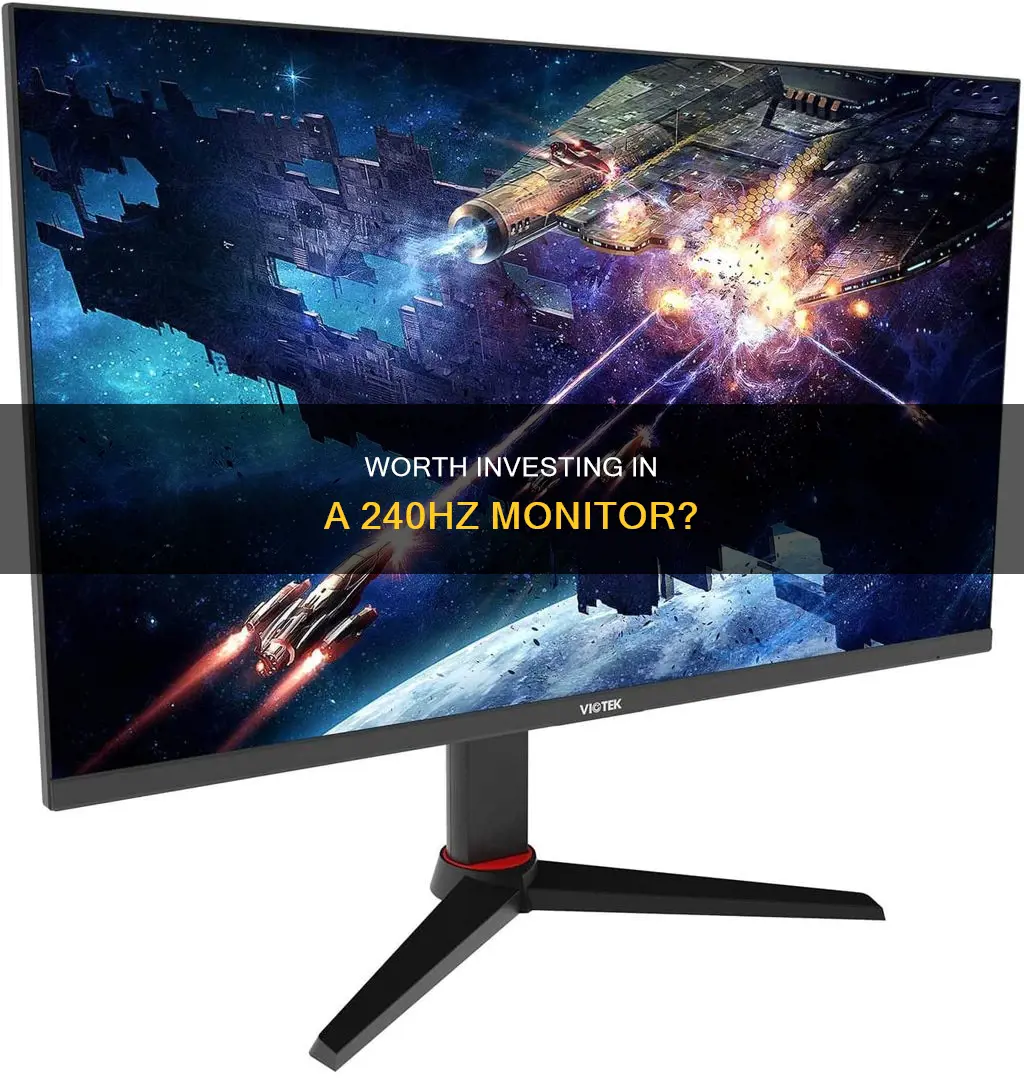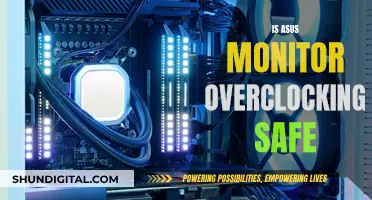
If you're a gamer, a 240Hz monitor could be a great investment. The higher the hertz, the more frames per second your monitor can display, giving you a competitive edge over your opponents with lower rates. This is especially true if you play action-packed or first-person shooter games where response time is critical for winning. However, it's important to note that the higher you go in terms of hertz, the more expensive monitors can get, and you may need a powerful graphics card to keep up with the high refresh rate. So, while a 240Hz monitor can enhance your gaming experience, it's not necessary for everyone, and you should consider your budget and hardware before investing in one.
| Characteristics | Values |
|---|---|
| Use case | Gaming |
| Advantage | Competitive edge |
| Advantage | Smoother experience |
| Advantage | Reduced motion blur |
| Advantage | Less eye strain |
| Advantage | Improved mouse accuracy |
| Advantage | Lower input lag |
| Advantage | Higher picture quality |
| Advantage | More fluid gaming |
| Disadvantage | Expensive |
| Disadvantage | Requires powerful hardware |
What You'll Learn
- Hz monitors are ideal for gaming, especially action-packed and first-person shooter games
- Hz monitors are more expensive than 144Hz monitors
- Hz monitors have a faster refresh rate than 144Hz monitors
- Hz monitors have a lower input lag than 144Hz monitors
- Hz monitors are harder to find than 144Hz monitors

240Hz monitors are ideal for gaming, especially action-packed and first-person shooter games
The benefits of a 240Hz monitor are most noticeable in fast-paced, competitive multiplayer games, where a split second can make all the difference. The higher refresh rate means you'll be able to react slightly faster to what's happening on screen, and the reduced motion blur will help reduce eye strain. If you play first-person shooters, fighting games, sports games, or racing games, a 240Hz monitor will give you an immediate advantage over players using 60Hz or 144Hz monitors.
While it's easy for the human eye to tell the difference between 60 and 144 FPS, it becomes harder to distinguish between 144 and 240 FPS. However, even if you can't see the difference, the lower lag and smoother response of a 240Hz monitor will still be there, improving your gameplay. Additionally, once you get used to a 240Hz monitor, it will be very noticeable and distracting if you go back to a lower refresh rate.
When choosing a 240Hz monitor, consider your gaming setup and budget. If you have a high-end graphics card, you'll want a monitor that can take advantage of its power, like a 1440p or 4K monitor. However, if you have a budget setup, a low-cost 1080p monitor will be a better option. You'll also want to look at the monitor's response time, input lag, and VRR support to ensure it's compatible with your graphics card.
Connecting an External Monitor to Your Sony Vaio Laptop
You may want to see also

240Hz monitors are more expensive than 144Hz monitors
240Hz monitors are designed for gaming, specifically for action-packed and first-person shooter games. They are worth the money for gamers who want a competitive edge and need to react quickly to targets in the game. The higher refresh rate reduces motion blur and gives smoother gameplay.
However, 240Hz monitors are very expensive, especially when compared to 144Hz monitors. This is because 240Hz monitors are high-performance monitors, with high refresh rates and low input lag, which come at a premium. 144Hz monitors, on the other hand, are more affordable as they strike a balance between performance and cost. They offer a high refresh rate that is more than sufficient for most users, including gamers, without the high price tag of 240Hz monitors.
While 240Hz monitors offer a noticeable improvement over 144Hz monitors in terms of speed and responsiveness, the difference is quite small and may not be worth the extra cost for many users. 144Hz monitors already provide a significant upgrade from standard 60Hz monitors, offering smoother gameplay and reduced motion blur. For most gamers, 144Hz is more than enough and provides a good balance between performance and affordability.
Additionally, monitors with higher refresh rates, such as 240Hz, often have lower resolutions, typically offering only up to 1440p resolution with most at 1080p. In contrast, higher-resolution monitors in the 4K range usually have lower refresh rates. So, if you value image quality and resolution over performance, a 144Hz monitor with higher resolution may be a better option than a 240Hz monitor.
In summary, while 240Hz monitors offer superior performance and are ideal for competitive gamers who want the fastest response times, they come at a significantly higher cost. 144Hz monitors provide a good balance between refresh rate and affordability, making them a more popular choice for gamers who want improved performance without breaking the bank.
Collab Edit: Browser Usage Monitored for User Experience
You may want to see also

240Hz monitors have a faster refresh rate than 144Hz monitors
240Hz monitors are designed with gaming in mind, and the higher refresh rate offers a range of benefits for gamers.
A 240Hz monitor will display 240 unique frames per second, with 4.17 milliseconds between each frame. In comparison, a 144Hz monitor displays 144 frames per second with 6.94 milliseconds between each frame. This means that a 240Hz monitor can display a new image 2.77 milliseconds faster than a 144Hz monitor. In competitive gaming, where every millisecond counts, this can give you a small advantage over other players.
The higher refresh rate of 240Hz monitors also results in lower input lag, which can improve your responsiveness in-game and enhance your overall gaming performance. Additionally, the faster refresh rate reduces motion blur, providing a smoother and more fluid gaming experience. This can be particularly beneficial for fast-paced games such as first-person shooters, where quick reactions and precise aim are crucial.
While the jump from 144Hz to 240Hz is not as significant as the leap from 60Hz to 144Hz, it still offers noticeable improvements. If you are a hardcore or professional gamer, especially in the FPS genre, investing in a 240Hz monitor can provide a competitive edge.
However, it is important to note that to fully utilise a 240Hz monitor, your PC rig must be capable of outputting high frame rates. Additionally, the benefits of a 240Hz monitor may be less noticeable for casual gamers or those who play slower-paced games.
Disassembling an AOC LCD Monitor: Step-by-Step Guide
You may want to see also

240Hz monitors have a lower input lag than 144Hz monitors
240Hz monitors are designed for gaming, where speed is a key spec. The higher the refresh rate, the lower the input lag, and a 240Hz monitor will provide a lower input lag than a 144Hz monitor, resulting in a clearer picture at any framerate.
A 240Hz monitor can display a new image every 4ms, while a 144Hz monitor can only manage this every 6.94ms. This means that a 240Hz monitor runs 2.77ms faster than a 144Hz monitor, which can make a significant difference in fast-paced games.
However, it's worth noting that the difference in performance between a 120Hz and a 144Hz monitor is negligible, and the jump to 240Hz from 120Hz is where a notable difference can be observed.
The benefits of a 240Hz monitor over a 144Hz monitor include reduced motion blur, smoother gameplay, and a more responsive feel. This can be particularly advantageous for gamers, especially in first-person shooter (FPS) games, where response time is critical for winning.
While a 240Hz monitor can provide a competitive edge, it may not be necessary for casual gamers or those who don't play fast-paced games. Additionally, the cost of a 240Hz monitor may be a factor to consider, as they tend to be more expensive than 144Hz monitors.
In summary, while a 240Hz monitor offers improved performance over a 144Hz monitor in terms of lower input lag, the benefits may be most noticeable to professional or competitive gamers who require the fastest response times.
Connecting a Monitor to Your Fender Passport Venue
You may want to see also

240Hz monitors are harder to find than 144Hz monitors
240Hz monitors are a lot harder to find than 144Hz monitors. This is because 240Hz monitors are designed for a very specific audience—gamers who want a competitive edge. The higher the refresh rate, the more expensive the monitor, and the harder it is to justify the cost.
240Hz monitors are also overkill for most people, even gamers. A 120Hz or 144Hz monitor is more than enough for most gaming needs, and a higher refresh rate won't make a noticeable difference for general use outside of gaming.
In addition, monitors with higher refresh rates usually offer lower resolutions, which is another disadvantage. While you get higher performance, you sacrifice image quality. This is why most people opt for monitors in the 60-144Hz range, as they provide a good balance of performance and visuals.
That being said, if you're a professional or extremely passionate gamer who needs the fastest response times, a 240Hz monitor could be worth considering. The extra milliseconds you save can give you a competitive edge and help you hit your targets faster. However, keep in mind that you'll need a powerful computer setup to take full advantage of a 240Hz monitor, including a high-end graphics card and CPU.
So, while 240Hz monitors are harder to find than 144Hz monitors, it's because they cater to a niche market of gamers who require the highest refresh rates for competitive gaming. For the average user, a 144Hz monitor will provide a more than satisfactory experience.
Determining the Age of Your Savannah Monitor
You may want to see also
Frequently asked questions
Yes, a 240Hz monitor is good for gaming. The higher the refresh rate, the lower the input lag, which means a clearer picture at any framerate. 240Hz monitors are ideal for action-packed and first-person shooter gaming.
Yes, a 240Hz monitor is worth it for all gamers, including casual gamers. If you play first-person shooter games, then a 240Hz monitor would be an excellent choice. There are also budget-friendly 240Hz monitors on the market.
It's difficult for the human eye to notice a difference between 144Hz and 240Hz. If you can see the difference and it helps you perform better in games, then a 240Hz monitor may be worth the expense. Otherwise, a 144Hz monitor may be more affordable and offer better visuals.







